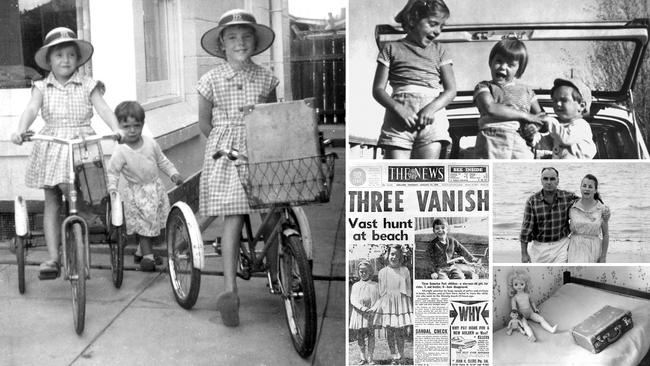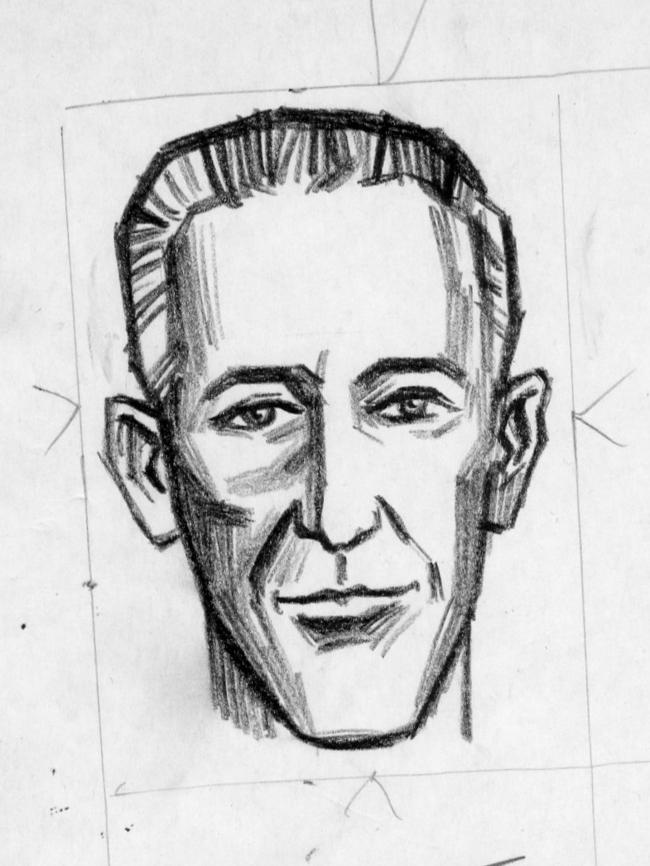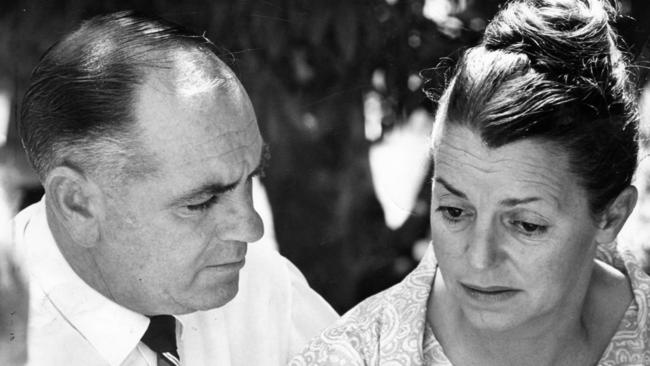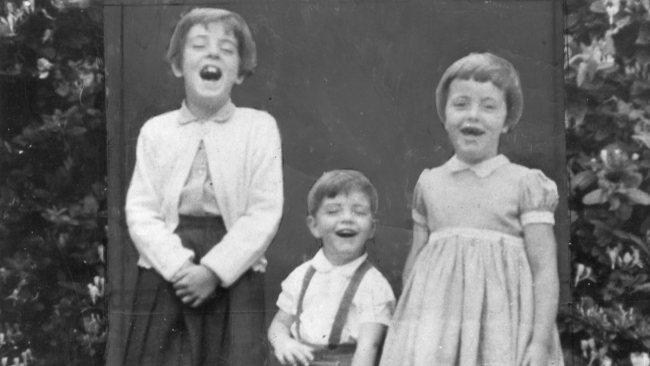Editor's note: The report originally ran in 2016, on the 50-year anniversary of the disappearance.
Most South Australians have walked on Glenelg Beach, swum in the shallows and strolled along the jetty of the state’s premier tourist town.
Jane, Arnna and Grant Beaumont loved to do all three. The children were locals, happy at home, at school and happiest of all being together at their favourite playground by the sea.
That they could literally disappear without any trace is still hard to believe 50 years after the event.
It remains the story that haunts every Australian parent.
To lose one child, as many parents have done, either through accident, illness, or by criminal means is a terrible tragedy.

But to lose three children — the only children you have — and to never see them again or to ever know their fate is beyond grief.
And then to have to live on for half a century, overwhelmed with guilt about what might have been, is an unthinkable torture.
Few people in the world can know for sure the agonies endured by Jim and Nancy Beaumont.
Imagine the Christmas season of 1966 for them as they watched other parents excitedly rushing around shopping to buy presents for their children.
And then on Christmas Day to suffer the hollow emptiness and soul-destroying silence of their Somerton Park house that had seen so many previous joyous occasions.
The committed Christians were told time after time, by people knocking on their Harding Street door during that initial year, that they “didn’t love their children enough” and were being “punished by God”.
But by every account the Beaumonts were caring, affectionate parents — rightly proud of their children — who did nothing wrong that fateful day.
They did what was commonplace in South Australia in 1966; they allowed their kids to catch a bus to the busy holiday spot they had visited many times before.
What could go wrong?
A time of change
Wednesday, January 26, 1966, dawned in Adelaide as another hot midsummer day, expected for a second consecutive day to exceed 38C.
Australians across the nation were excitedly preparing for the introduction of the new decimal currency, marking the end of its British-style currency system based on pounds, shillings and pence.
It was scheduled to occur in less than three weeks on February 14.
There had been a concerted program to educate the public including extensive media coverage, highlighted by the famous “Dollar Bill” campaign with video.
Around 105 million 1 cent and 2 cent pieces had been minted in preparation.
The other major event that day was the imminent resignation of Sir Robert Menzies.
Every radio and TV broadcast carried the news that, after more than 16 years in office, Australia’s longest-serving Prime Minister had retired on the morning of Australia Day to be succeeded by Harold Holt.
Ironically, within two years the new Prime Minister would also go missing at a beach, Cheviot Beach in Victoria, while swimming. He too was never found.
That fateful morning
In the modest Beaumont house — still standing today on the corner of Petersen and Harding streets in Somerton Park — nine-year-old Jane got up early but as usual during holidays she chose to read in her bed rather than jump straight up for breakfast.
An intelligent, talented child, the Paringa Park Primary School student was reading the Louisa May Alcott classic novel Little Women.
Far more reserved than her siblings, Jane — who stuttered when excited — had recently joined the Third Somerton Brownie pack and Girl Guides.
The last letter
A letter written two days before her disappearance shows her to be responsible and caring beyond her tender years.
The letter had been left for her parents, who had been out dancing.
“Dear Mum and Dad, I am just about to go to bed and the time is 9. I have put Grant’s nappy on so there is no need to worry about his wetting the sheet. Grant wanted to sleep in his own bed so one of you will have to sleep with Arnna ... Good night to you both. Jane XXX
P.S. I hope you had a nice time wherever you went.
P.P.S. I hope you don’t mind me taking your radio into my room Daddy.”
Seven-year-old Arnna — the unusual spelling was the idea of Nancy who much preferred it to Anna — had completed Grade 2 at Paringa Park Primary and was said to be more affectionate and dependent than Jane but without her studious nature.
Grant, who was four-and-a-half, adored his sisters and was thought to be bright like Jane.
They all loved the beach, although Grant hated seaweed, and soon after breakfast they were angling for their mother to let them head back to Glenelg.
They had been to the beach the day before and come home on their own.
Jim Beaumont, a former taxi driver now making his living selling linen from the back of a van, had dropped the children off close to the Glenelg Town Hall.
Unbeknown to his kids, he watched them for half an hour to make sure they were all right.
Jane could swim but the others couldn’t and were paddling in the shallows.
Seeing them happily playing with other children, the father left for a routine business trip heading north to Snowtown around 150km away.
It was the last time the man, said to have a quiet charm, would ever see his children.

That Tuesday, the Beaumont children returned home at 2pm having walked the 2.5km distance from the beach.
Next day, with the heat up early and promising to be yet another scorcher, they were keen to be beachside and began pestering their mother.
Each child had been given a bicycle for Christmas and already that holidays had ridden down to Broadway, left the bikes chained up and walked to Glenelg along the shorefront.
That morning Nancy decided they would be safer taking the bus that dropped them in the centre of Glenelg and insisted they be on the midday bus back to be home soon after 12.15pm.
She gave Jane eight shillings and sixpence — about 85 cents in pre-decimal currency — for bus fares and lunch and told her to bring her a pastie home for lunch.
Shortly after 10am, Nancy Beaumont waved off her youngsters from the gate and watched them walk the 100m to Diagonal Rd.
Her normal life was about to come to an end.
Jane carried three towels in an airline-style shoulder bag and all three children wore bathers with shorts over the top, which was common attire for those living close to the sea.
From Stop 26 on Diagonal Rd it was a 10 minute bus ride to Glenelg on the route that began at Seacombe Gardens.
The red and white bus was owned by R. Worthley and Sons Ltd and the driver was a Mr I.D. Munro, of South Brighton, who remembered the children getting on the bus but not where they got off.
A female passenger also recalled seeing them and was taken that the oldest was reading Little Women, which she thought might be a little old for her.
She said the children left the bus at the Moseley St stop just around the corner from Jetty Rd.
What happened in the next 45 minutes is not clear but several witnesses suggested the children followed their usual routine of swimming in the shallows near the jetty before running up to Colley Reserve.
The most robust sighting occurred here around 11am by a 74-year-old woman seated on a bench in front of the Holdfast Bay Sailing Club, who saw them playing under a sprinkler on the Colley Reserve lawns.
A school friend of Jane’s also claimed to have seen them there at that time, but did not stop to speak.
The mystery man
The elderly woman said she saw a blond man in dark blue swimming trunks lying face down on a towel, watching the children wash down.
Around 15 minutes later, she saw the same man playing with the children who were laughing and clearly having fun.
The younger girl and the boy were jumping over him as he lay on the grass and the older girl was hitting him with her towel.
They were still playing together when she left the area just before noon, when the children should have been on their way to catch the bus home.


An elderly couple told police they were approached by a man with a similar description to the suspect in the company of three children who asked, “Did any of you people see anyone with our clothes? We’ve had some money taken from our clothes.’’
Another witness, a middle-aged woman sitting nearby, saw this interaction and said the man was clearly “with the children” as she then watched him help the children put their shorts on over their bathers.
It struck her as odd because she thought the eldest was old enough to dress herself.
This account was most worrying to Nancy Beaumont, who could not consider Jane letting anyone — and certainly not a stranger — dress her.
It also brought back with a shudder a comment Arnna had made the week before and that she had totally dismissed.
Arnna told her mother, “Jane has a boyfriend down at the beach”.
The next sighting was around midday, when the children purchased pasties, a pie and some drinks from Wenzels cake shop using a £1 note that could only have been given to them by someone else.
Wenzels still has a shop in Glenelg on Jetty Rd but this one was on Moseley St, and the stop where they should have caught the bus home was just outside.
If these accounts are correct, the children clearly had no intention of following their mother’s strict instruction to be on the midday bus.
The vanishing
The last corroborated sighting was by the elderly couple back at Colley Reserve, who said at the time they left the beach — 12.15pm — they saw the three children waiting on a seat close to the Colley Reserve changerooms.
They assumed they were waiting for the man with the blue bathers to come out fully dressed.
The woman was able to describe the children’s clothing, right down to the airline-type bag the oldest girl was carrying.
It was the Beaumont children and they had missed the midday bus home.
Two additional possible sightings of the children later that day proved difficult to corroborate.
A tourist from Broken Hill said at 1.45pm he saw a man matching the description of the suspect leaving the beach with three children — but that leaves 90 minutes with no other sightings.
Someone who knew the children well was the family postman, Tom Patterson, of Kipling Ave, Glengowrie.
He told police he saw the children in Jetty Rd on their own “holding hands and laughing”. “We all stopped and the children said ‘It’s the postie’,’’ he said later.
But he couldn’t remember if he saw them at the beginning of his round at 1.45pm or the completion of the round at 2.55pm.
Given the unsubstantiated nature of these sightings, police determined that they could not be relied upon.
Nancy Beaumont spent the morning visiting a friend and arrived home before the noon bus to be home for her children.
But they never arrived.
She considered they had missed the bus and would catch the next one at 2pm or had chosen to walk home.
When they weren’t home on the two o’clock bus she waited for the three o’clock bus and then she began to panic.
Jim Beaumont got home soon after, having aborted his trip north with little success as the heat and the holidays had seen most of his clients leave Snowtown.
With concern rising rapidly, the couple drove to the beach to search for their children.

They returned home in despair and just after 4pm headed to the police station to report them missing.
Even at 5pm, Nancy thought they might be on the next bus. But when they weren’t she told Jim: “There is only one reason the kiddies are not home — someone is holding them, stopping them from coming home.”
When uniformed police visited the Harding St home and searched it top to bottom, the terrible reality of what had occurred began to sink in.
Nancy said later everything became a blur from that time on.
Jim spent the night in a police patrol car trawling the suburban beachside streets with a loud speaker blaring out “have you seen three small children?”
By the morning of January 27, 1966, the entire nation knew three children from Adelaide were officially missing.
A week of hell
At the end of the initial week without her children, Nancy Beaumont was telling everyone she believed they were dead.
But she changed her mind in the months afterwards, realising it would be impossible to live on without hope.
“Not until there is evidence that they are not on this earth any more will I give up hope,’’ she said just before Christmas 1966.

A year on from her children’s disappearance Nancy was still questioning, “Why did I let the children go to the beach on their own that day?”
She rationalised that the beach and school were the same distance and her two girls walked to school together each day.
She had always considered they would be safe.
On the 50th anniversary of the disappearance of Jane, Arnna and Grant a plea the Beaumont family made in 1968 still rings true — “Somebody somewhere in this world knows something.’’


Here’s what you can expect with tomorrow’s Parramatta weather
As spring moves into summer what can locals expect tomorrow? We have the latest word from the Weather Bureau.
Here’s what you can expect with tomorrow’s Parramatta weather
As spring moves into summer what can locals expect tomorrow? We have the latest word from the Weather Bureau.